Genoa – Genova
- Maria Scuor
- Dec 28, 2023
- 7 min read
Italiano in ogni sezione
On this day we took a road trip with our cousins Mimma and Guido. Destination was Genoa or Genova in Italian. This is a city and the capital of Italian region Liguria. In 2023, it is the 6th largest city in Italy with 558,745 people living within the city limits.
Genova is situated on the Gulf of Genova in the Ligurian Sea and historically it has been one of the most important ports on the Mediterranean. It also was one of the most powerful maritime republics from the 11th to 18th century and it played a leading role in commercial trade in Europe. Nicknamed “La Superba (The Proud One)” by Francesco Petrarch because of its glories on the seas and impressive landmarks. The city has had massive shipyards and steelworks since the 19th century.
The port covers 700 hectares of land, 500 hectares of water and stretches 22 kilometres along the coastline. With a trade volume of 51.6 million tonnes, it is the second busiest port in Italy after port of Trieste. It has five berths for cruise ships and 13 for ferries which accounts for 4 million ferry passengers, 1.5 million cars and 250,000 trucks per year. There are two lighthouses: the historical Lanterna, 249 ft (76 metres) tall and the smaller lighthouse of Punta Vango. And finally, there is a marina where many sailboats and yachts are moored.
In questo giorno abbiamo fatto un viaggio con i nostri cugini Mimma e Guido. La destinazione era Genova. Questa è una città e il capoluogo della regione italiana Liguria. Nel 2023 è la 6° città più grande d'Italia con 558.745 persone che vivono all'interno dei confini della città.
Genova è situata sul Golfo di Genova nel Mar Ligure e storicamente è stata uno dei porti più importanti del Mediterraneo. Fu anche una delle più potenti repubbliche marinare dall'XI al XVIII secolo e svolse un ruolo di primo piano nel commercio in Europa. Soprannominata "La Superba" da Francesco Petrarca per le sue glorie sui mari e i suoi monumenti impressionanti. La città ha avuto enormi cantieri navali e acciaierie dal 19 ° secolo.
Il porto si estende per 700 ettari di terra, 500 ettari di acqua e si estende per 22 km lungo la costa. Con un volume di scambi di 51,6 milioni di tonnellate, è il secondo porto più trafficato d'Italia dopo il porto di Trieste. Ha cinque ormeggi per le navi da crociera e 13 per i traghetti, che rappresentano 4 milioni di passeggeri traghetti, 1,5 milioni di auto e 250.000 camion all'anno. Ci sono due fari: lo storico Lanterna, alto 249 piedi (76 metri) e il faro più piccolo di Punta Vango. E infine, c'è un porto turistico dove sono ormeggiate molte barche a vela e yacht
Here are some photos of the port - Ecco alcune foto del porto
In the 15th century two of the worlds earliest banks were founded in Genova: The Bank of Saint George, founded in 1407, which was the oldest state deposit bank it the world at its closure in 1805 and Banca Cariage, founded as a mount of piety (institutional pawnbroker run as a charity). The Banca had over 500 branches all over the country before being acquired by BPER Bank in 2022. It is documented that Christopher Columbus, who was born in Genova in 1451, donated one-tenth of his income from his discoveries in the Americas to the Bank of Saint George for the relief of taxation on foods.
Nel XV secolo furono fondate a Genova due delle prime banche del mondo: la Banca di San Giorgio, fondata nel 1407, che era la più antica banca di deposito statale del mondo alla sua chiusura nel 1805 e la Banca Cariage, fondata come un monte di pietà (banco dei pegni istituzionale gestito come ente di beneficenza). La Banca contava oltre 500 sportelli bancari su tutto il territorio nazionale prima di essere acquisita da BPER Bank nel 2022. È documentato che Cristoforo Colombo, nato a Genova nel 1451, donò un decimo delle sue entrate derivanti dalle sue scoperte nelle Americhe alla Banca di San Giorgio per l'alleggerimento della tassazione sui cibi.
Like most cities in Italy, Genova has many churches, actually close to 40. We saw these three:
Come la maggior parte delle città d'Italia, Genova ha molte chiese, in realtà quasi 40. Abbiamo visto questi tre:
Bailica of our Lady of Assumption - Basilica di Nostra Signora Assunta
Basilica of our Lady of Assumption, which is located on Piazza Francesco Baracca. It was originally consecrated in 1620 but later that year the decision was reversed because of frictions with nearby parishes. After several more years of friction, it was consecrated by Bishop Vincenzo Spinola in 1629. It was built in baroque style and in 1624 the bell tower was added. The basilica has gone through several renovations with the most recently completed in 2006.
Basilica di Nostra Signora Assunta, che si trova in Piazza Francesco Baracca. Fu originariamente consacrata nel 1620, ma più tardi nello stesso anno la decisione fu annullata a causa di attriti con le parrocchie vicine. Dopo diversi anni di attriti, fu consacrata dal vescovo Vincenzo Spinola nel 1629. Fu costruita in stile barocco e nel 1624 fu aggiunto il campanile. La basilica ha subito diversi restauri, l'ultimo dei quali è stato completato nel 2006. Ecco alcune foto di questa chiesa
Here are some photos of this church - Ecco alcune foto di questa chiesa
Cathedral of Saint Lawerence - Cattedrale di San Lorenzo (Duomo)
Cathedral of Saint Lawerence is dedicated to Saint Lawrence and is the seat of the Archbishop of Genova. It was consecrated by Pope Gelasius II in 1118 and built between the 11th and 14th century. The building side naves of Romanesque style while the main façade is Gothic. The bell tower and dome were built in the 16th century. The Cathedral was very lucky on February 9, 1941, when the bomb that landed in the south-eastern corner didn’t detonate. The shell is still there and there is an inscription “This bomb, launched by the British Navy, though breaking through the walls of this great cathedral, fell here unexploded on February 9, 1941. In perpetual gratitude, Genoa, the City of Mary, desired to engrave in stone, the memory of such grace.”
La Cattedrale di San Lorenzo (Duomo di Genova) è dedicata a San Lorenzo ed è la sede dell'Arcivescovo di Genova. Fu consacrata da papa Gelasio II nel 1118 e costruita tra l'XI e il XIV secolo. Le navate laterali dell'edificio sono di stile romanico mentre la facciata principale è gotica. Il campanile e la cupola furono costruiti nel XVI secolo. La Cattedrale fu molto fortunata il 9 febbraio 1941, quando la bomba che cadde nell'angolo sud-orientale non esplose. Il proiettile è ancora lì e c'è una scritta “QUESTA BOMBA, LANCIATA DALLA FLOTTA INGLESE, PUR SFONDANDO LE PARETI DI QUESTA INSIGNE CATTEDRALE, QUI CADEVA INESPLOSA IL IX FEBBRAIO MCMXLI, A RICONOSCENZA PERENNE, GENOVA, CITTÀ DI MARIA, VOLLE INCISA IN PIETRA, LA MEMORIA DI TANTA GRAZIA”
Here are some photos of the cathedral - Ecco alcune foto della cattedrale
Church of Jesus and Saints Ambrose and Andrew - La Chiesa di Gesù e dei Santi Ambrogio e Andrea
Church of Jesus and Saints Ambrose and Andrew is located in the city center in Piazza Matteotti, next to Piazza De Ferrari. The original church of Saint Ambrose dates back to 569 but the building is passed to the Jesuits in 1552 who rebuilt it in its current form by 1598 and was kept as a Jesuits College until 1773 when it became the Catholic church.
Heavily damaged by the French navel attack in 1684, it was redecorated by Lorenzo De Ferrari by the beginning of the 18th century. The façade was rebuilt and completed in 1894 and two statues of Saint Ambrose and Saint Andrew were inserted into the church. There are many beautiful frescoes, pictorial works on canvas, bronze candelabra, and other statues.
La Chiesa di Gesù e dei Santi Ambrogio e Andrea si trova nel centro della città in Piazza Matteotti, accanto a Piazza De Ferrari. La chiesa originaria di Sant'Ambrogio risale al 569 ma l'edificio passò ai Gesuiti nel 1552 che lo ricostruirono nella sua forma attuale entro il 1598 e fu mantenuto come Collegio dei Gesuiti fino al 1773 quando divenne la chiesa cattolica.
Pesantemente danneggiata dall'attacco all'ombelico francese nel 1684, fu ridecorata da Lorenzo De Ferrari all'inizio del XVIII secolo. La facciata fu ricostruita e completata nel 1894 e nella chiesa furono inserite due statue di Sant'Ambrogio e Sant'Andrea. Ci sono molti bellissimi affreschi, opere pittoriche su tela, candelabri in bronzo e altre statue.
Here are some photos of this church - Ecco alcune foto di questa chiesa

Piazza de Ferrari
Piazza de Ferrari is located in the heart of the city in the ancient Portoria district, it is the main square in Genova. It represents the commercial, financial and economic hub, as well as being the main point of reference for most of the important events of the city. The piazza is named after Raffaele De Ferrari, Duke of Galliera, Prince of Lucedio, politician and banker and its current appearance took shape in the 20th century when three streets Via XX Settembre, Via Dante and Via Patrarca were constructed.
At the center of the piazza is the renowned bronze fountain which was designed by architect Giuseppe Crosa in 1936. What is really cool about this piazza is the mix of ancient and modern buildings and institutions. You can easily spend hours just looking at the architecture. The piazza was named in 1875 a year before De Ferrari died and in 1893 the equestrian statue of Giuseppi Garibaldi the most historical figure in his era, was inaugurated.
Here are some photos of Piazza de Ferrari
Piazza de Ferrari si trova nel cuore della città nell'antico quartiere di Portoria, è la piazza principale di Genova. Rappresenta il fulcro commerciale, finanziario ed economico, oltre ad essere il principale punto di riferimento per la maggior parte degli eventi importanti della città. La piazza è intitolata a Raffaele De Ferrari, duca di Galliera, principe di Lucedio, politico e banchiere e il suo aspetto attuale ha preso forma nel XX secolo quando furono costruite tre strade: Via XX Settembre, Via Dante e Via Patrarca.
Al centro della piazza si trova la famosa fontana in bronzo progettata dall'architetto Giuseppe Crosa nel 1936. Ciò che è davvero bello di questa piazza è il mix di edifici e istituzioni antiche e moderne. Puoi facilmente passare ore solo a guardare l'architettura. La piazza fu intitolata nel 1875, un anno prima della morte di De Ferrari, e nel 1893 fu inaugurata la statua equestre di Giuseppi Garibaldi, la figura più storica della sua epoca.
Here are some photos of Piazza de Ferrari - Ecco alcune foto di Piazza de Ferrari

We spent an amazing day in Genova with family and here are some photos around town that show the beauty of this city. If you visit Milan, I recommend a side trip to Genova. It is well worth the trip.
Abbiamo trascorso una fantastica giornata a Genova con la famiglia ed ecco alcune foto in giro per la città che mostrano la bellezza di questa città. Se visitate Milano, vi consiglio un escursione a Genova. Ne vale la pena.






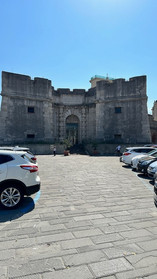

























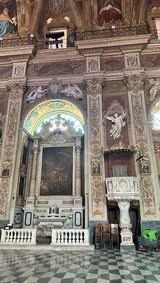





















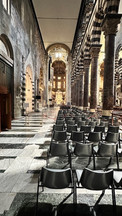
























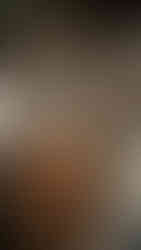
















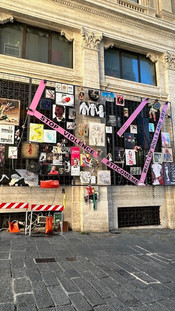





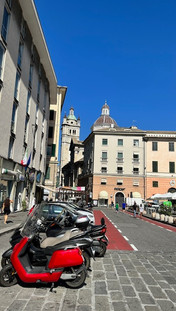


















Kommentare